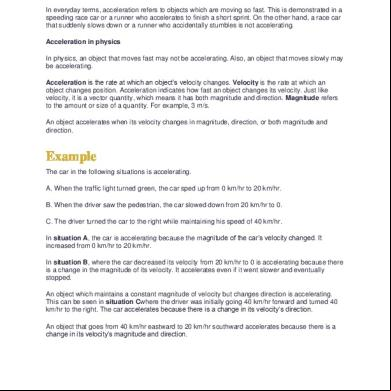Acceleration In Everyday Usage 6e635n
This document was ed by and they confirmed that they have the permission to share it. If you are author or own the copyright of this book, please report to us by using this report form. Report 2z6p3t
Overview 5o1f4z
& View Acceleration In Everyday Usage as PDF for free.
More details 6z3438
- Words: 483
- Pages: 2
Acceleration in everyday usage In everyday , acceleration refers to objects which are moving so fast. This is demonstrated in a speeding race car or a runner who accelerates to finish a short sprint. On the other hand, a race car that suddenly slows down or a runner who accidentally stumbles is not accelerating. Acceleration in physics In physics, an object that moves fast may not be accelerating. Also, an object that moves slowly may be accelerating. Acceleration is the rate at which an object’s velocity changes. Velocity is the rate at which an object changes position. Acceleration indicates how fast an object changes its velocity. Just like velocity, it is a vector quantity, which means it has both magnitude and direction. Magnitude refers to the amount or size of a quantity. For example, 3 m/s. An object accelerates when its velocity changes in magnitude, direction, or both magnitude and direction.
Example The car in the following situations is accelerating. A. When the traffic light turned green, the car sped up from 0 km/hr to 20 km/hr. B. When the driver saw the pedestrian, the car slowed down from 20 km/hr to 0. C. The driver turned the car to the right while maintaining his speed of 40 km/hr. In situation A, the car is accelerating because the magnitude of the car’s velocity changed. It increased from 0 km/hr to 20 km/hr. In situation B, where the car decreased its velocity from 20 km/hr to 0 is accelerating because there is a change in the magnitude of its velocity. It accelerates even if it went slower and eventually stopped. An object which maintains a constant magnitude of velocity but changes direction is accelerating. This can be seen in situation Cwhere the driver was initially going 40 km/hr forward and turned 40 km/hr to the right. The car accelerates because there is a change in its velocity’s direction. An object that goes from 40 km/hr eastward to 20 km/hr southward accelerates because there is a change in its velocity’s magnitude and direction.
Objects that move in uniform circular motion have constant speeds but still accelerate because they constantly change in direction as they go around the circular path. Satellites orbiting the Earth maintain a nearly circular orbit and travel very fast at an almost constant speed like the International Space Station which moves at approximately 27 000 km/hr. Even though these satellites have constant speeds, they are accelerating because they constantly change direction as they move in a circular path around the Earth.
Key Points
In everyday usage, acceleration refers to fast moving objects such as a speeding race car. In physics, acceleration is the rate of change in an object’s velocity. An object accelerates when there is a change in its velocity – which means there could either be a change in its magnitude, direction, or both magnitude and direction.
Example The car in the following situations is accelerating. A. When the traffic light turned green, the car sped up from 0 km/hr to 20 km/hr. B. When the driver saw the pedestrian, the car slowed down from 20 km/hr to 0. C. The driver turned the car to the right while maintaining his speed of 40 km/hr. In situation A, the car is accelerating because the magnitude of the car’s velocity changed. It increased from 0 km/hr to 20 km/hr. In situation B, where the car decreased its velocity from 20 km/hr to 0 is accelerating because there is a change in the magnitude of its velocity. It accelerates even if it went slower and eventually stopped. An object which maintains a constant magnitude of velocity but changes direction is accelerating. This can be seen in situation Cwhere the driver was initially going 40 km/hr forward and turned 40 km/hr to the right. The car accelerates because there is a change in its velocity’s direction. An object that goes from 40 km/hr eastward to 20 km/hr southward accelerates because there is a change in its velocity’s magnitude and direction.
Objects that move in uniform circular motion have constant speeds but still accelerate because they constantly change in direction as they go around the circular path. Satellites orbiting the Earth maintain a nearly circular orbit and travel very fast at an almost constant speed like the International Space Station which moves at approximately 27 000 km/hr. Even though these satellites have constant speeds, they are accelerating because they constantly change direction as they move in a circular path around the Earth.
Key Points
In everyday usage, acceleration refers to fast moving objects such as a speeding race car. In physics, acceleration is the rate of change in an object’s velocity. An object accelerates when there is a change in its velocity – which means there could either be a change in its magnitude, direction, or both magnitude and direction.










